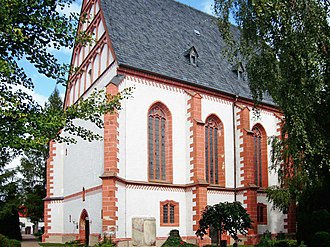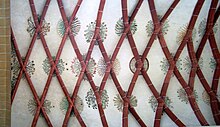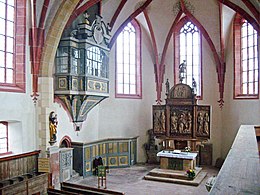Marienkirche (Rötha)
The Marienkirche in Rötha is a former pilgrimage church built in the Gothic style . It stands in a cemetery and is used today as a room for funeral services and, because of its Silbermann organ, for concerts. On special occasions such as Maundy Thursday , Good Friday , on Easter Eve and on St. John's Day , church services take place. It belongs to the Protestant parish Leipziger Neuseenland in the church district Leipziger Land and is a listed building .
history
According to a legend, around 1502 the mother of God Mary appeared three times to a shepherd under a pear tree at a spring near Rötha , who asked him to build a pilgrimage church here. The bark of the tree is said to have healed sick sheep as well. The pear tree and the fountain soon became very popular. After initially building a small wooden chapel, the Benedictine nuns of the Georgenkloster in Leipzig arranged for a pilgrimage church to be built in 1510, which was initially also called the Church of the Holy Pear Tree .
Around 1518 the church was completed in its present form. Although the western end seems a bit abrupt and may indicate an early completion of construction due to the beginning of the Reformation , the sometimes widespread opinion that the church is only the choir of a much larger planned one cannot be approved for that reason alone, since there is a space between the nave and the chancel Triumphal arch exists, which otherwise would not have been built.
During the reign of George the Bearded , pilgrimages to Rötha continued. When his successor Heinrich the Pious introduced the Reformation in Saxony in 1539, the Marienkirche was consecrated as a Gottesackerkirche in the Protestant faith.
After the Thirty Years' War , under the patronage of the von Friesen auf Rötha aristocratic family , a partially baroque renovation of the church's furnishings with pulpit , galleries , baptismal font and stately box began in the 1680s, culminating in the construction of the Silbermann organ in 1722. In 1896/1897 the Marienkirche was restored under the direction of the architect Theodor Quentin .
In 1932 a storm knocked over the 14 meter high turret , which severely damaged the roof and left the church to decay in the following years. The roof could only be completely renewed from 1950, which was followed by a complete reconstruction by 1957. The current external appearance of the church in terms of plaster and color, analogous to the time it was built, is the result of the repairs between 1991 and 1997.
architecture
The Röthaer Marienkirche is a hall church with internal dimensions of 24.8 meters long and 12.5 meters wide. The choir of the same width has a five-eighth ending . The outer front is structured by stepped buttresses . Three -part pointed arched windows with tracery sit on a high positioned all-round coffin cornice . The base area has two-part arched curtain windows . Colored chessboard friezes run under the coffin and main cornice . The church has three portals with vestments . The steep roof is slated. The upper part of the west gable carries tracery with keel arches .
A two-story extension is attached to the choir on the north side. It contains two separate rooms, whereby the upper one can only be reached via an external staircase, which was newly built in 2013. At the time of pilgrimages, rooms were used as rooms. After the Reformation, the upper one was opened to the church as a patron s box, the lower one became the sacristy . At the gable of the extension, the tracery extends beyond the wall and forms a kind of stepped gable.
The 13 meter high nave is spanned by a three- bay ribbed vault, the ribs of which are double grooved. The crossing points of the vault are surrounded by depictions of plants from one of the first printed herbal books of the Middle Ages, the Hortus sanitatis , and were only exposed again during the reconstruction in the 1950s. In the choir, which is separated from the nave by a triumphal arch, the vault ends in a diamond star.
The church contains a three-sided gallery, which is designed as a two-storey organ gallery on the west side.
Furnishing
The furnishings of the church come partly from the time the building was built, partly from the Baroque period between 1680 and 1720. The winged altar dates from the time it was built from 1525–1530, which is attributed to a “Master of Rötha” . The altar was in color in the baroque focus has been, but is now back in the original holzsichtig. The central shrine shows the coronation of Mary by God the Father and Christ . The scene is surrounded by clouds and angels, above which the dove hovers as a symbol of the Holy Spirit . In the left side wing are the figures of John the Baptist and the Apostle Andrew , in the right the helpers Katharina and Barbara .
The saints Florian , George and Mauritius stand in a burst above a round arched field . In the round arch, a relief picture shows the meeting of Anna and Joachim , Mary's parents, in front of the golden gate of the Jerusalem temple after Joachim's return from fasting in the desert - a much-cited topic in Christian art. Because of the existing sheep, the scene is sometimes interpreted (for example by Richard Steche: Marienkirche (Rötha) ) as a meeting of the Rötha shepherd from the pear tree legend with a Leipzig nun to build the church, but this is due to the clothes of the people and also because of the Action may not apply. In the predella , the Lord's Supper is depicted as a relief carving. It was stolen in 1948, but could be purchased again in 2012.
On the north pillar of the triumphal arch a crescent moon Madonna is placed. It is dated around 1520 and ascribed to the Saxon carver Stephan Hermsdorf. The baptismal font is made of wood; the inset brass bowl is engraved with “1683”. The pulpit, decorated with winding columns, also dates from this period. Its eight-pointed star-shaped sound cover, which has been missing since 1964, was reconstructed in 2012 based on historical photos.
On the left side of the choir protrudes a decoratively designed wooden case, which represents the opening of the patronage box. Since 2013, it has included an exhibition on the von Friesen family and the history of Rötha Castle, in particular its role during the Battle of Nations in 1813.
The baroque furnishings also include closed prayer chairs for the wealthy citizens and the parish families in the choir. The prayer chairs and the galleries received a decorative painting in the Regency style , which presumably originated from the Saxon court painter Johann Christian Buzäus and which were almost unaltered during the last renovation.
Silbermann organ
In 1721 the church patron, the Röthaer castle lord Christian August Freiherr von Friesen, ordered an instrument for the Marienkirche from Gottfried Silbermann after the organ in the Georgenkirche had been completed. The new organ was consecrated as early as 1722. In addition to the nine registers of the contract, Silbermann had added a pedal with a 16 'subbass and another manual register. In 1833 Urban Kreutzbach from Borna added a pedal coupler to the organ .
In 1917, 29 silent prospect pipes were melted down for war purposes and replaced again in 1935. The organ was relocated in 1942 because the building fell into disrepair after the storm in 1932. In the Bach year of 1950 it was temporarily shown in the hall of the Old Town Hall in Leipzig and in the Berlin Bach exhibition.
In 1960 the instrument was restored by Hermann Eule Orgelbau Bautzen and placed again in the Marienkirche. Another extensive restoration was carried out in 2008 by the organ building company Ekkehart Groß from Waditz . In contrast to the organ in St. Georgen, the tuning is not on the same level, but is based on the tempering originally created by Silbermann in 1722.
|
|
|||||||||||||||||||||||||||||||||||||||||||||||||||||
Web links
- The Marienkirche. In: Website of the Förderverein Marienkirche Rötha. Accessed September 1, 2020 .
- Richard Steche : Marienkirche (Rötha). In: Descriptive representation of the older architectural and art monuments of the Kingdom of Saxony. 15. Issue: Amtshauptmannschaft Borna . CC Meinhold, Dresden 1891, p. 103.
- Marienkirche Rötha. In: Text of the list of monuments. Accessed September 1, 2020 .
- Ev Marienkirche Rötha. In: architektur-blicklicht.de. Accessed September 1, 2020 .
Individual evidence
- ^ Church in the Leipziger Land. Accessed September 1, 2020 .
- ↑ List of cultural monuments in Rötha , ID number 09259352
- ^ Birgit Franke: Medieval pilgrimage in Saxony - a work report. In: Late medieval pilgrimage in central Germany. Contributions to an interdisciplinary workshop, June 2002, Eisleben, p. 112. Accessed on September 1, 2020 .
- ↑ Architectural and art monuments of the Kingdom of Saxony, Issue 15, p. 104
- ↑ Ev. Marienkirche Rötha. Accessed September 1, 2020 .
- ↑ The Marienkirche. In: Website of the Förderverein Marienkirche Rötha. Accessed September 1, 2020 .
- ^ Förderverein Rötha (last sentence). Accessed September 1, 2020 .
- ^ The Gottfried Silbermann organ of St. Marien. Accessed September 1, 2020 .
- ^ Rötha - Marienkirche, organ from 1722. In: Website of the Gottfried Silbermann Society. Accessed September 1, 2020 .
Coordinates: 51 ° 11 ′ 45 " N , 12 ° 24 ′ 45.2" E





